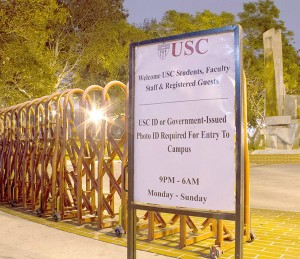USC sees a drop in on-campus crime
Over the course of this past year, USC has seen a decrease in on-campus crime. Administrative officials are attributing this reduction to the various new security measures implemented following the Halloween night shooting on campus in 2012.

Barriers · The fencing surrounding the university’s campus was erected in January 2013, as well as restricted hours from 9 p.m. to 6 a.m. – Austin Vogel | Daily Trojan
The Halloween incident occurred at an on-campus party, and left one victim in critical condition and three others injured. Those involved in the shooting were not affiliated with the university.
The bulk of the new security measures following the shooting were implemented in January 2013. One of the main stipulations was that students, staff and registered guests entering campus between the hours of 9 p.m. and 6 a.m. are required to show campus identification at the eight entrances that remain open.
The university also added security and license plate recognition cameras, and hired additional security personnel to monitor the gates during the restricted hours. More workers were also brought on to provide 24-hour security in the on-campus residential halls where students are now required to scan their fingerprint prior to entry.
Carlisle said he attributes much of the crime reduction on campus to the restricted hours that the gates remain open.
“The bottom line is that security measures have reduced crime in the residential halls,” Carlisle said. “Also, we think [the new measures] reduced other thefts around campus because it’s harder for thieves to get in after 9 p.m.”
Security personnel are also often stationed outside USC’s 24-hour Leavey Library and patrons entering the building, as well as those already inside, are required to show a student ID after 9 p.m.
Though DPS will not yet disclose specific statistics, Carlisle said the department analyzes crime on a weekly and sometimes daily basis, and has seen a noticeable decrease in crime since the implementation of the security measures.
Official statistics from DPS will be compiled in a few months as part of the Jeanne Clery Disclosure of Campus Security Policy and Campus Crime Statistics Act, which requires college campuses to document three calendar years of campus crime statistics and make a report available to the public by Oct. 1 of each year.
The Los Angeles Times, in a June 14th article, reported LAPD data that indicated 49 instances of burglary or theft on campus during the overnight hours in 2012, compared to only 23 instances in 2013. According to police records gathered by the newspaper, instances of violent crime, including robberies and aggravated assaults, also fell from 11 cases in 2012 to just four in 2013.
Because, however, official DPS data has not been released, Carlisle noted that this data may not be completely accurate. Los Angeles, Carlisle said, is divided into various reporting districts, which maintain their own crime statistics. USC is its own reporting district and the aforementioned statistics reflect LAPD reports in the area, rather than DPS’s own recordings. Carlisle said DPS and LAPD will discuss and reconcile statistics prior to the release of the Clery report.
“[The LAPD] numbers to me look exaggerated because there are some in there that wouldn’t necessarily be in our Clery numbers,” Carlisle said. “Although, they should be if we are both following the same guidelines.”

